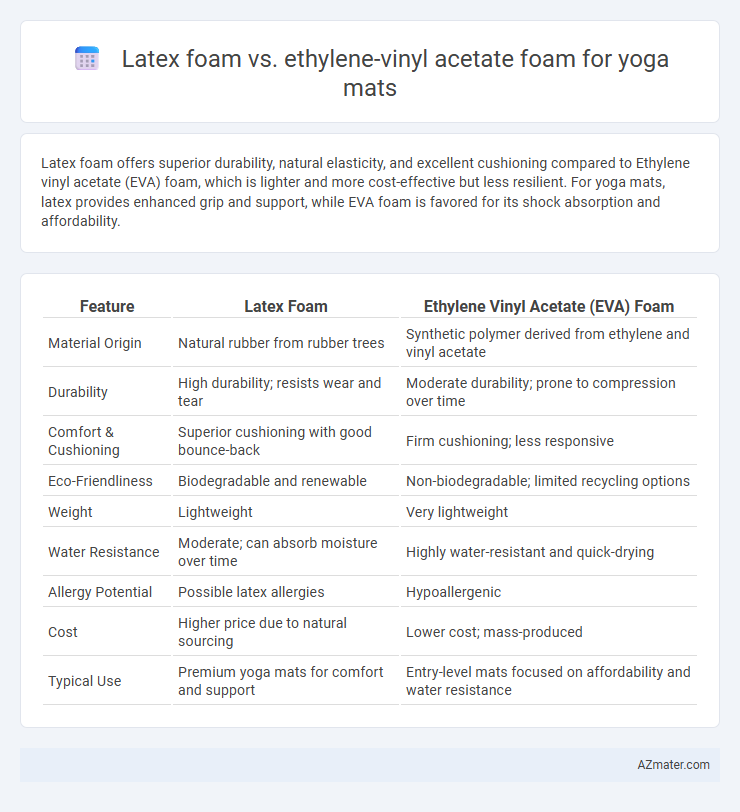Latex foam offers superior durability, natural elasticity, and excellent cushioning compared to Ethylene vinyl acetate (EVA) foam, which is lighter and more cost-effective but less resilient. For yoga mats, latex provides enhanced grip and support, while EVA foam is favored for its shock absorption and affordability.
Table of Comparison
| Feature | Latex Foam | Ethylene Vinyl Acetate (EVA) Foam |
|---|---|---|
| Material Origin | Natural rubber from rubber trees | Synthetic polymer derived from ethylene and vinyl acetate |
| Durability | High durability; resists wear and tear | Moderate durability; prone to compression over time |
| Comfort & Cushioning | Superior cushioning with good bounce-back | Firm cushioning; less responsive |
| Eco-Friendliness | Biodegradable and renewable | Non-biodegradable; limited recycling options |
| Weight | Lightweight | Very lightweight |
| Water Resistance | Moderate; can absorb moisture over time | Highly water-resistant and quick-drying |
| Allergy Potential | Possible latex allergies | Hypoallergenic |
| Cost | Higher price due to natural sourcing | Lower cost; mass-produced |
| Typical Use | Premium yoga mats for comfort and support | Entry-level mats focused on affordability and water resistance |
Introduction to Yoga Mat Materials
Latex foam offers excellent elasticity and durability, making it ideal for yoga mats that require superior cushioning and resilience during dynamic poses. Ethylene vinyl acetate (EVA) foam provides lightweight, water-resistant properties with moderate cushioning, favored for its affordability and easy maintenance. Choosing between latex foam and EVA foam depends on the desired balance of comfort, support, and budget for yoga practice.
What is Latex Foam?
Latex foam is a natural material derived from the sap of rubber trees, known for its excellent elasticity, durability, and breathability, making it ideal for yoga mats that require cushioning and support. It provides superior resilience and responsiveness, helping maintain posture alignment during practice while offering antimicrobial and hypoallergenic properties. Compared to Ethylene vinyl acetate (EVA) foam, latex foam tends to be more eco-friendly and breathable, enhancing comfort for extended yoga sessions.
What is Ethylene Vinyl Acetate (EVA) Foam?
Ethylene Vinyl Acetate (EVA) foam is a soft, flexible, and durable material commonly used in yoga mats for its excellent cushioning and shock absorption properties. Its closed-cell structure resists moisture and provides superior grip, making it ideal for various yoga styles and exercises. EVA foam is lightweight, non-toxic, and often favored for its affordability and ease of maintenance compared to latex foam.
Comfort and Cushioning: Latex vs EVA Foam
Latex foam offers superior comfort and cushioning for yoga mats due to its natural elasticity and resilience, providing excellent support and pressure relief during poses. Ethylene vinyl acetate (EVA) foam, while slightly less responsive, delivers durable cushioning with good shock absorption, making it a cost-effective choice for moderate comfort. Both materials provide effective cushioning, but latex foam tends to adapt better to body contours, enhancing overall comfort for extended practice sessions.
Durability and Longevity Comparison
Latex foam offers superior durability and resilience, maintaining its shape and cushioning for years without significant degradation, making it ideal for high-use yoga mats. Ethylene vinyl acetate (EVA) foam, while more affordable and lightweight, tends to compress over time and may develop cracks or tears with prolonged use. Consequently, latex foam yoga mats provide longer-lasting support and structural integrity compared to EVA foam options.
Grip and Slip-Resistance Factors
Latex foam offers superior grip and slip-resistance for yoga mats due to its natural elasticity and tacky surface texture, providing enhanced stability during poses. Ethylene vinyl acetate (EVA) foam, while lightweight and cushioning, tends to have a smoother surface that may reduce grip, especially when wet or sweaty. For practitioners prioritizing slip-resistance and secure footing, latex foam mats deliver better performance compared to EVA foam options.
Eco-Friendliness and Sustainability
Latex foam, derived from natural rubber trees, offers superior eco-friendliness and sustainability compared to Ethylene Vinyl Acetate (EVA) foam, which is petroleum-based and less biodegradable. Latex mats decompose naturally, reducing environmental impact, while EVA mats persist in landfills due to their synthetic composition. Choosing latex foam supports renewable resource use and lower carbon footprints in yoga mat production.
Hypoallergenic Properties: Which is Safer?
Latex foam offers natural hypoallergenic properties due to its organic origin and resistance to dust mites and mold, making it a safer choice for individuals with allergies. Ethylene vinyl acetate (EVA) foam, although synthetic, is generally non-toxic and resistant to allergens but may cause sensitivity in people with chemical sensitivities. Consumers seeking the safest hypoallergenic yoga mat often prefer natural latex foam for its superior ability to minimize allergic reactions.
Price and Value for Money
Latex foam yoga mats typically cost more due to their natural, hypoallergenic properties and superior durability, offering excellent value for customers seeking long-term use and eco-friendliness. Ethylene vinyl acetate (EVA) foam mats are more budget-friendly, providing good cushioning and lightweight comfort but often sacrificing longevity and environmental benefits. Evaluating price against durability and environmental impact helps determine the best value for money between these two materials.
Choosing the Right Yoga Mat: Latex or EVA Foams?
Latex foam offers superior elasticity, durability, and natural antimicrobial properties, making it ideal for supportive and long-lasting yoga mats. Ethylene vinyl acetate (EVA) foam provides lightweight cushioning, excellent shock absorption, and is often more affordable, suitable for beginners or those seeking a softer surface. When choosing the right yoga mat, prioritize latex for enhanced grip and resilience, while EVA is preferable for budget-friendly, lightweight options with moderate durability.

Infographic: Latex foam vs Ethylene vinyl acetate foam for Yoga mat
 azmater.com
azmater.com